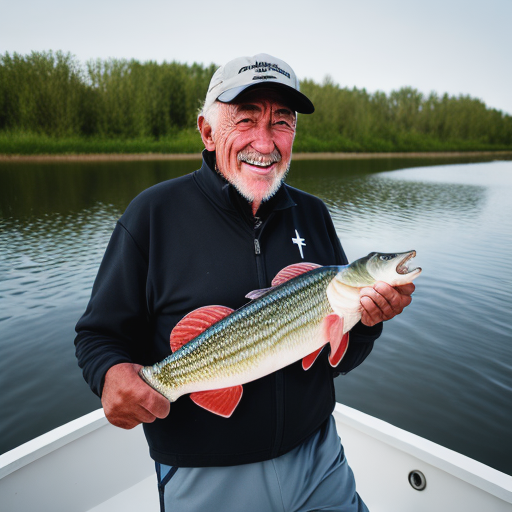Welcome to our in-depth exploration of the fascinating world of trout spawning behavior. Understanding the intricacies of trout reproduction is key to unlocking the secrets of catching trophy-sized trout and contributing to their conservation. In this article, we will delve into the habits and patterns that define the spawning behavior of trout, shedding light on their reproductive strategies and providing valuable insights for anglers.
Key Takeaways:
- The behavior and movements of trout during the spawning season play a crucial role in their reproduction.
- Currents, habitat quality, and thiamine levels in eggs can all impact trout spawning success and population dynamics.
- Trophy-sized trout often exhibit solitary and nocturnal behavior, making strategic fishing efforts during dawn, dusk, or low-light conditions more effective.
- Trout feeding preferences become more selective as they grow larger, requiring anglers to understand their diet and mimic their preferred prey.
- Competition for food among trout populations necessitates strategic angling techniques to stand out in the feeding environment and attract larger individuals.
Solitude in Darkness
Trophy-sized trout often adopt a solitary and nocturnal lifestyle, making them elusive and challenging to catch. To increase your chances of enticing these cautious predators, it’s important to focus your fishing efforts during specific times of the day. Dawn, dusk, and low-light conditions provide the ideal opportunity to target these majestic creatures.
Understanding the spawning season and reproductive cycle of trout is crucial for successful fishing. The trout spawning season typically occurs during the spring and fall, although it may vary depending on the species and location. During this time, trout exhibit different behaviors and preferences as they prepare to reproduce. By familiarizing yourself with the trout reproductive cycle, you can align your fishing techniques and bait offerings accordingly.
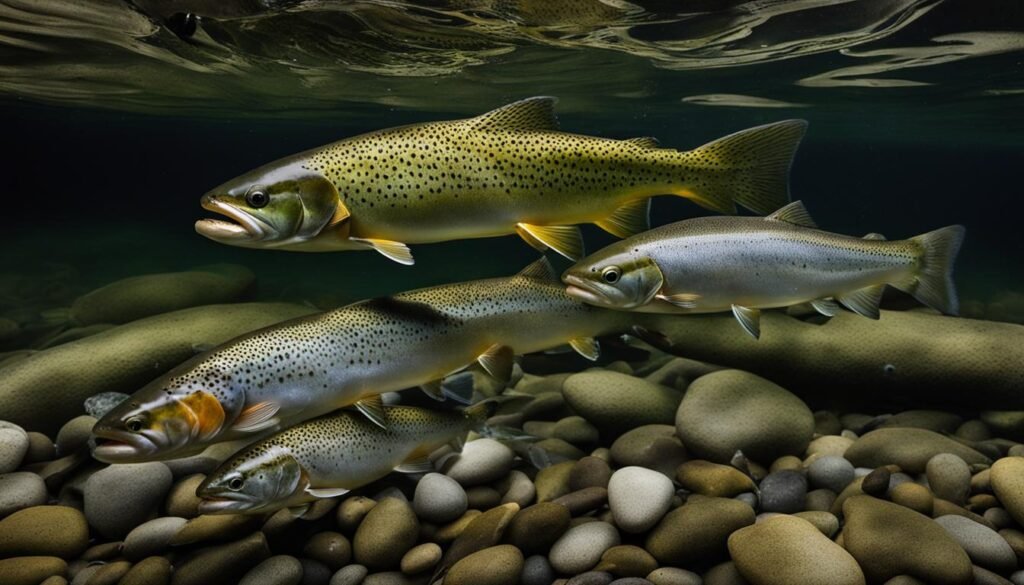
Trout reproduction is a complex process influenced by various factors such as water temperature, water flow, and available food sources. By analyzing these factors and understanding how they impact trout behavior, you can strategically plan your fishing trips to maximize your chances of success.
When fishing during the trout spawning season, it’s important to approach the water with care and respect for the fish and their habitat. Practicing catch-and-release techniques and avoiding disruption of their spawning grounds will help preserve the trout population for future generations of anglers.
Selectivity in Feeding
As trout grow larger, their feeding preferences become more discerning. Understanding their diet and preferences is key to increasing fishing success and attracting trophy-sized individuals.
Trout have a varied diet that includes insects, crustaceans, small fish, and even mice. By imitating their preferred prey, anglers can effectively entice trout and improve their chances of landing a trophy-sized catch.
Diet Preferences of Trout
- Baitfish: Trout are known to feed on small fish like minnows and shiners. Flies that mimic baitfish can be highly effective in attracting larger trout.
- Crayfish: Crayfish are a favorite food source for many trout species. Crayfish imitation patterns can closely resemble their natural prey and entice strikes from selective fish.
- Larger Insects: Adult trout have a preference for larger insects such as stoneflies, damselflies, and dragonflies. Flies that imitate these insects can be successful in enticing trophy trout.
By matching the hatch and using flies that closely resemble the trout’s preferred prey, anglers can increase their chances of success. Observing the feeding behavior of trout in the area and adjusting fly choices accordingly can make a significant difference in fishing outcomes.
“Understanding the diet and preferences of trout is crucial for successful angling. By imitating their preferred prey, anglers can effectively attract trophy-sized trout.” – Expert Angler
To further enhance your understanding of trout feeding habits, here is a table summarizing the preferred diet and corresponding fly patterns:
| Diet | Preferred Flies |
|---|---|
| Baitfish | Streamers, Woolly Buggers |
| Crayfish | Crayfish Patterns, Clouser Minnows |
| Larger Insects | Stonefly Patterns, Dragonfly Nymphs |
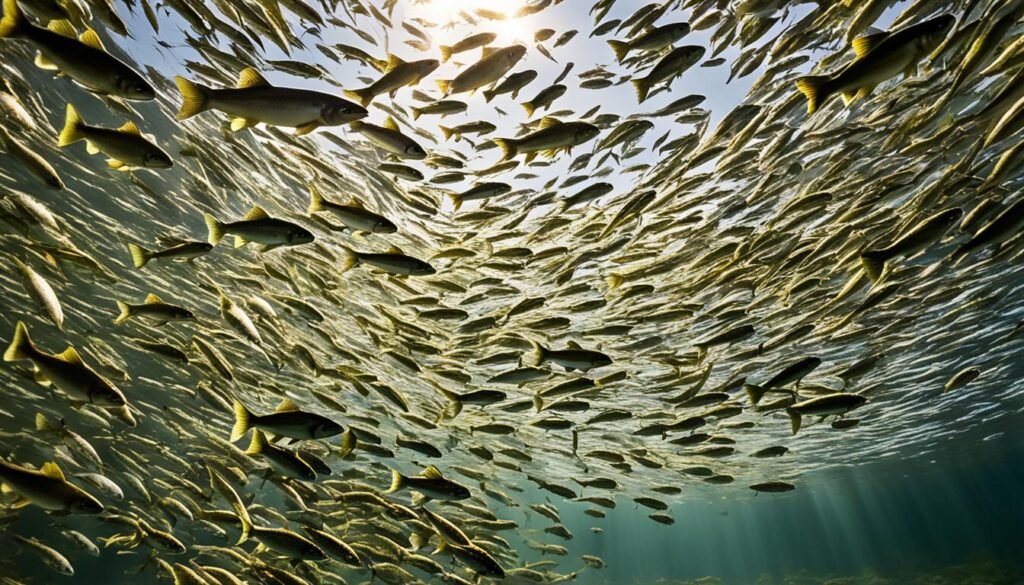
Understanding trout feeding preferences and adapting to their dietary choices is essential for targeting trophy-sized trout. By utilizing the right flies and imitating their preferred prey, anglers can increase their chances of a successful catch.
Competition for Food
Intraspecific competition for food is a significant factor influencing the behavior and feeding patterns of trout populations. Understanding the dynamics of competition can provide valuable insights for anglers seeking to target trophy-sized individuals.
When competing for limited food resources, larger trout often dominate feeding areas, making it essential to identify these key locations. By focusing efforts in areas where larger trout are prevalent, anglers can maximize their chances of attracting trophy-sized fish.
One effective technique is to use larger flies that stand out in the competitive feeding environment. These larger flies can grab the attention of larger trout, increasing the likelihood of enticing them to strike.
Exploiting aggression among trout can also be advantageous for anglers. Aggressive trout are more likely to attack and feed on larger prey, such as baitfish or crayfish imitations. By selecting flies that imitate these food sources, anglers can play into the competitive nature of trout and increase their chances of attracting larger individuals.
Example Flies for Competition Fishing
| Fly Pattern | Size |
|---|---|
| Nymphs | 12-16 |
| Streamers | 4-8 |
| Crayfish imitations | 6-10 |
| Baitfish imitations | 4-8 |
Using these fly patterns and sizes can effectively imitate the preferred food sources of larger trout and increase the chances of enticing them to bite. Remember to adjust the presentation and retrieve techniques to mimic the natural movements of the selected food sources.
“When targeting trophy-sized trout, it’s crucial to understand the competitive nature of their feeding behavior. By strategically selecting fishing areas, using larger flies, and exploiting aggression, anglers can increase their chances of catching elusive trophy trout.” – Expert Angler
Availability of Food
Larger trout exhibit shifts in dietary preferences throughout the year, necessitating adjustments in fly selection. To maximize fishing success, it is essential to adapt fly choices based on the seasonal variations in prey availability. Understanding the availability of food sources can significantly improve your chances of effectively targeting trophy-sized trout.

Dietary Shifts in Larger Trout
As trout grow larger, their dietary preferences evolve. They become more selective in their feeding habits and often develop a preference for specific prey. By accurately imitating the preferred prey through fly selection, you can increase your chances of enticing larger trout.
| Season | Prey Availability | Recommended Fly Patterns |
|---|---|---|
| Spring | Insects, such as mayflies, caddisflies, and stoneflies | Dry flies imitating specific insect species |
| Summer | Aquatic insects, terrestrials, and small fish | Wet flies, nymphs, and streamers imitating various prey species |
| Fall | Baitfish and larger insects | Streamers and larger nymph patterns |
| Winter | Opportunistic feeding on smaller fish and nymphs | Small streamers and nymph patterns |
Seasonal Prey Availability and Fly Choices
Understanding the seasonal variations in prey availability is crucial when planning your fishing trips. By aligning your fly choices with the prevalent prey species during different seasons, you can increase your chances of attracting trophy-sized trout. Here are some general guidelines:
- In spring, focus on imitating the emergence of specific insect species, such as mayflies, caddisflies, and stoneflies.
- In summer, diversify your fly selection to represent a wider range of aquatic insects, terrestrials, and small fish.
- In fall, target prey species like baitfish and larger insects with streamers and larger nymph patterns.
- In winter, adapt your approach to smaller fish and nymphs, utilizing small streamers and nymph patterns.
Remember, trout are opportunistic feeders and are highly influenced by the availability of food sources. By understanding their feeding habits and adjusting your fly choices accordingly, you can significantly increase your chances of enticing trophy-sized trout.
Territorialism and Spawning Behavior
During the spawning season, understanding the territorial behavior of trout is crucial for successful fishing. By focusing fishing efforts on strategic locations where trophy trout establish their territories, anglers can increase their chances of success.
Trout territories are areas that individuals defend for mating and spawning purposes, making them prime spots for anglers looking to catch trophy-sized trout. When targeting these territorial trout, using flies that mimic threats or prey can be highly effective in enticing a strike.
One key aspect of trout spawning behavior is the ritualistic courtship between males and females. Trout mating rituals involve various displays and behaviors that occur before the actual spawning takes place. These rituals often include elaborate movements, changes in coloration, and the creation of nests, known as redds, where the female deposits her eggs.
Inhabiting rivers and lakes, trout display different spawning habits. River-spawning trout populations, such as those found in the Dog River, Ontario, have been identified alongside their lake-spawning counterparts. Understanding these habits enables anglers to locate and target spawning trout more effectively.
“Concentrating fishing efforts on strategic locations where trophy trout establish territories and using flies that mimic threats or prey can increase the chances of success.”
It is important to practice ethical angling during trout spawning periods to ensure the preservation of fish populations. Responsible angling includes handling fish with care, avoiding overfishing specific areas, and respecting fishing regulations and guidelines.
Inspired by their natural instincts and drives, trout spawning behavior is both fascinating and intricate. By gaining knowledge of these behaviors, anglers can enhance their fishing strategies and increase their chances of catching trophy-sized trout.
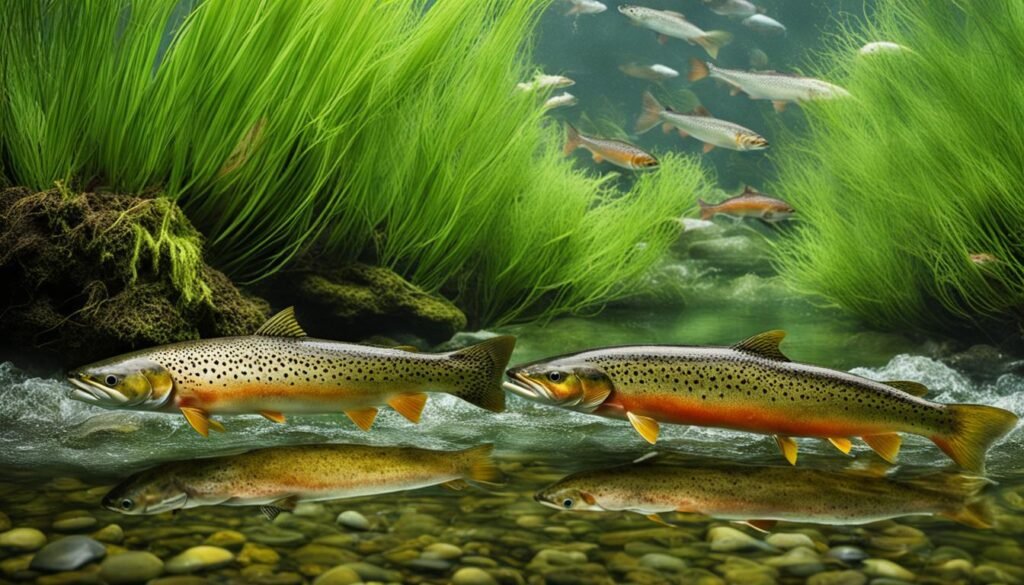
Trout Spawning Behavior Table
| Territorial Behavior | Spawning Habits | Mating Rituals |
|---|---|---|
| Trout establish territories for mating and spawning. | Trout can spawn in both rivers and lakes. | Trout engage in elaborate courtship rituals before spawning. |
| Anglers can target territorial trout for higher chances of success. | Understanding trout spawning habits helps in locating potential fishing spots. | Observing trout mating rituals provides insight into their reproductive processes. |
| Using flies that mimic threats or prey can lure territorial trout. | Trout spawning behavior varies between river-spawning and lake-spawning populations. | Trout mating rituals include displays, movements, and nest creation. |
Tactical Angling Approaches
When targeting trophy trout, employing tactical angling approaches can significantly increase your chances of success. Utilizing subsurface fishing techniques, such as nymphs and streamers, is particularly effective in enticing trophy-sized individuals. Mastering streamer fishing and experimenting with different fly patterns, sizes, and retrieval techniques can help you unlock the secrets of trophy trout fishing.
Streamer fishing involves imitating small fish or other prey items to trigger the predatory instincts of trout. By presenting a realistic imitation, you can entice larger, more aggressive individuals. Experimenting with different patterns, sizes, and retrieval speeds allows you to hone in on what works best for the specific trout population you’re targeting.
When selecting a streamer, consider the type of prey prevalent in the trout’s environment. Opt for patterns that mimic baitfish, sculpins, or leeches. These patterns should have realistic coloration and movement, enticing trout to strike. Varying the size of your streamer can also be effective, as larger trout tend to be more attracted to larger prey.
In addition to streamers, nymphs can be invaluable in targeting trophy trout. Nymph fishing involves imitating aquatic insect larvae that form a significant part of a trout’s diet. By presenting nymph patterns, you can effectively imitate natural food sources and trigger feeding responses.
Subsurface Fishing Tips for Trophy Trout
“Mastering streamer fishing involves experimenting with different patterns, sizes, and retrieval techniques to entice trophy-sized trout.”
- Use sinking or intermediate sinking fly lines to get your flies down to the desired depth swiftly.
- Vary your retrieval speeds to imitate the movement of prey and trigger predatory instincts.
- Pay attention to water currents and structure. Target areas where trout are likely to hold, such as deep pools, eddies, or undercut banks.
- When nymph fishing, use a weighted fly to keep it near the bottom where trout are often feeding.
- Experiment with different nymph patterns to match the specific insects present in the trout’s habitat.
- Consider using indicators or Euro-nymphing techniques to detect strikes when fishing with nymphs.
By incorporating these tactical angling approaches into your fishing strategy, you can increase the odds of enticing trophy-sized trout. Remember, patience and persistence are key when pursuing these elusive creatures.
Tactical Angling Approaches Table:
| Technique | Advantages |
|---|---|
| Streamer Fishing |
|
| Nymph Fishing |
|
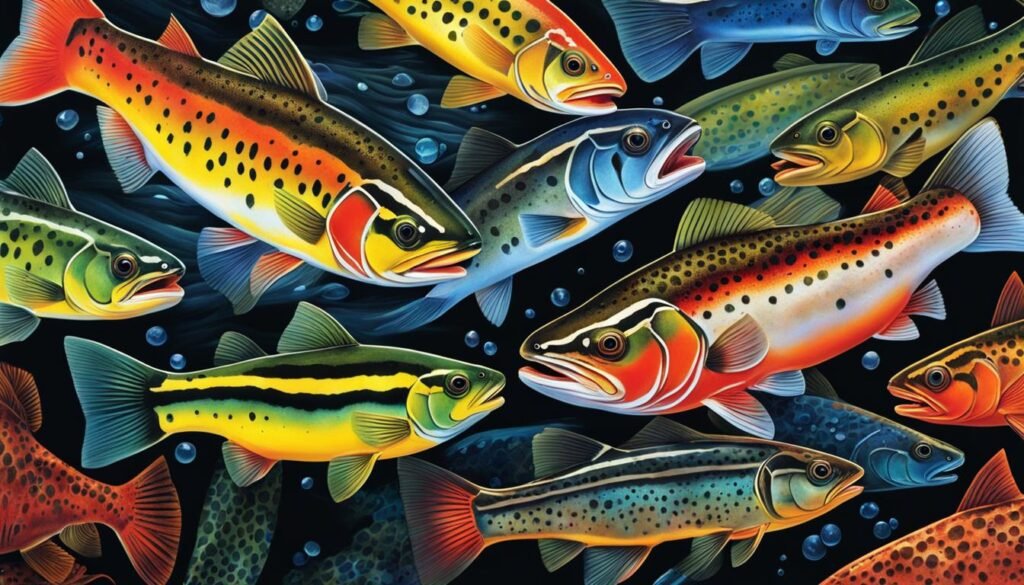
Suggested Fly Patterns and Sizes
Different fly patterns and sizes can be used to imitate various prey species and attract trophy trout. By understanding the trout spawning habits, reproductive strategies, and spawning season, anglers can choose the most effective fly patterns and sizes to increase their chances of success.
Here are some recommended fly patterns for targeting trophy trout:
- Nymphs: These small aquatic insects are a favorite food source for trout. Use nymph fly patterns to mimic these larvae, which often dwell near the bottom of rivers and lakes. Recommended sizes range from #12 to #18, depending on the specific species of nymph you are imitating.
- Streamers: Streamer flies imitate larger prey such as baitfish, leeches, or crayfish. Their lively and animated movement can trigger aggressive responses from trophy trout. Choose streamer patterns in sizes #4 to #10 to target larger, more predatory trout.
- Mouse Patterns: During the summer months, mice often end up in the water and become potential meals for trout. Mouse patterns, typically tied on larger hooks such as #4 to #8, can be incredibly effective in enticing larger trout seeking terrestrial prey.
- Baitfish Imitations: Trout are opportunistic predators and will readily strike at baitfish imitations. Mimic the appearance and movement of small fish with realistic baitfish patterns, such as Zonkers, Deceivers, or Clouser Minnows. Sizes #2 to #6 are generally effective for imitating baitfish.
Remember to adjust your fly selection based on the specific trout species and local conditions. Pay attention to the size and appearance of the natural prey in the water to select the most realistic fly pattern that matches the trout’s preferred food source.
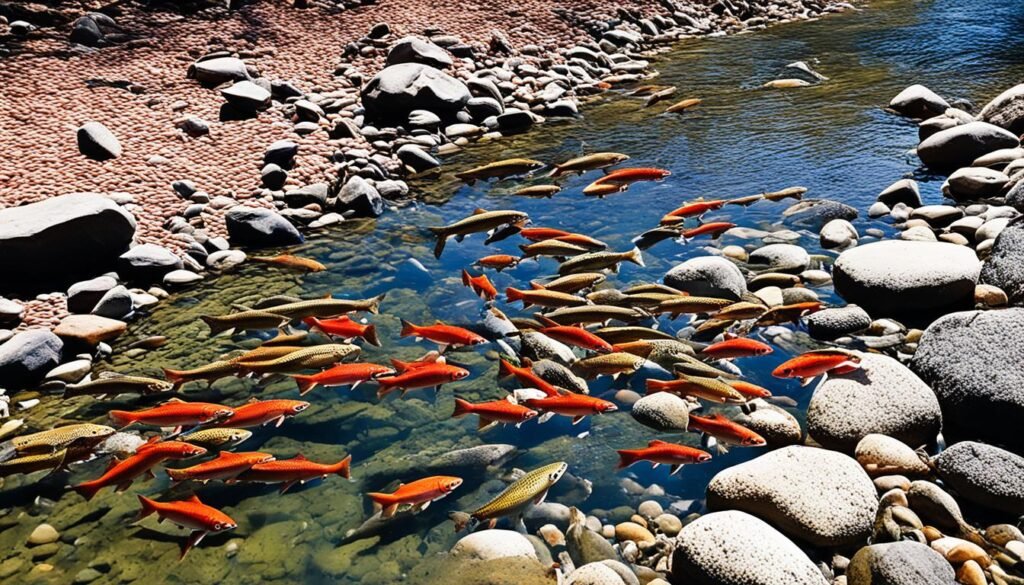
Fly Patterns and Sizes for Targeting Trophy-Sized Trout
| Fly Pattern | Recommended Size |
|---|---|
| Nymphs | #12 to #18 |
| Streamers | #4 to #10 |
| Mouse Patterns | #4 to #8 |
| Baitfish Imitations | #2 to #6 |
Behavioral Dynamics of Trophy Trout
Trophy-sized trout exhibit unique behavioral patterns that can greatly influence fishing success. Understanding these dynamics, including their solitary and nocturnal nature, as well as their selective feeding habits, is crucial for anglers aiming to target these elusive and impressive fish.
When it comes to behavior, trophy trout often prefer solitude and tend to be more active during the cover of darkness. This nocturnal behavior allows them to navigate their surroundings with increased stealth, making them more cautious and less likely to fall for typical fishing strategies during daylight hours.
Additionally, trophy trout are known for their selective feeding patterns. As they grow in size, their appetites become more discerning, favoring larger prey items. This behavior poses a challenge for anglers who must carefully choose fly patterns that mimic the preferred prey species, such as baitfish or larger insects, in order to attract the attention of these trophy-sized individuals.
To maximize your chances of success, it is essential to tailor your fishing techniques to the behavioral dynamics of trophy trout. Here are some strategies to consider:
- Timing: Plan fishing excursions during the low-light hours of dawn and dusk, when trophy trout are more active and likely to be on the move.
- Fly Selection: Choose fly patterns that accurately imitate the prey species favored by trophy trout, focusing on realistic baitfish imitations and larger insects.
- Stealth: Approach fishing areas with caution, minimizing disturbances in the water and maintaining a low profile to avoid alerting trophy trout to your presence.
By understanding the behavioral dynamics of trophy trout and implementing targeted fishing techniques, anglers can increase their chances of landing these prized fish. Keep in mind that successful fishing for trophy trout requires patience, skill, and a thorough understanding of their unique habits and preferences.
“To catch trophy trout, you must think like a trophy trout. Consider their behavior and preferences, and adjust your approach accordingly.”
| Behavioral Dynamics of Trophy Trout | Key Insights |
|---|---|
| Solitary and Nocturnal Behavior | Trophy-sized trout prefer solitude and are more active during low-light conditions, making them more challenging to catch during daylight hours. |
| Selective Feeding Habits | Trophy trout have discerning tastes, favoring larger prey items such as baitfish and larger insects. Anglers should choose fly patterns that accurately imitate their preferred prey. |
| Fishing Techniques | To target trophy-sized trout, anglers should plan fishing trips during dawn and dusk, select appropriate fly patterns, and approach fishing areas with stealth to avoid alerting the cautious trout. |
Lake Trout Spawning Movements
Studying the spawning movements of lake trout in large aquatic systems can be challenging. Acoustic telemetry has provided valuable insights into the movements of individual fish within and between spawning seasons. Tracking the movements of lake trout can help identify spawning sites and understand their reproductive behaviors.
Acoustic telemetry involves attaching small transmitters to individual fish and using underwater receivers to detect and record their movements. This technology allows researchers to monitor the precise locations and behaviors of lake trout during their critical spawning periods.
By tracking the movements of lake trout, scientists have observed distinct patterns in their spawning behaviors. For example, lake trout often migrate to specific areas in rivers or along rocky shorelines to deposit their eggs. They may also exhibit territorial behaviors, aggressively defending their spawning sites against other fish.
The Benefits of Acoustic Telemetry for Lake Trout Research
Acoustic telemetry has revolutionized our understanding of trout spawning habits and reproduction. Here are some key benefits of using this technology:
- Precise Tracking: Acoustic telemetry allows researchers to track individual fish movements in real-time, providing detailed information about their spawning locations and behaviors.
- Long-Term Monitoring: By monitoring lake trout movements over multiple spawning seasons, researchers can gain insights into their reproductive cycles and breeding patterns.
- Site Identification: By tracking the movements of lake trout, scientists can identify important spawning sites and develop strategies to protect and restore these critical habitats.
The data collected through acoustic telemetry has contributed significantly to the conservation and management of lake trout populations. This technology helps scientists make informed decisions about habitat preservation, fishing regulations, and other conservation efforts.
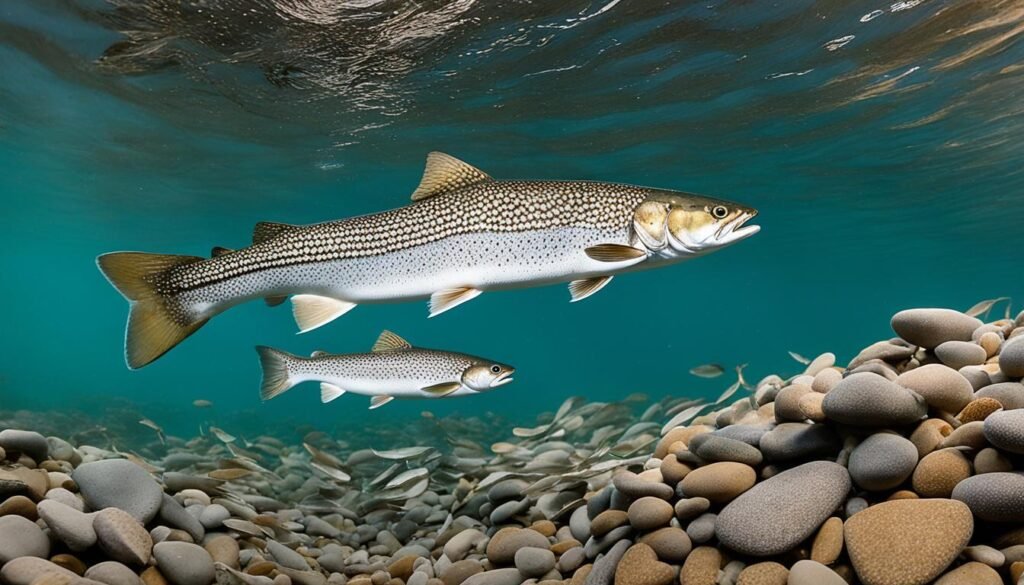
The Future of Lake Trout Research
As technology continues to advance, we can expect further advancements in the study of lake trout spawning movements. Researchers are continuously improving acoustic telemetry methods to collect more precise data, such as tracking fish in three dimensions and monitoring their physiological responses during spawning.
“Acoustic telemetry has been a game-changer in understanding how lake trout move and reproduce. This technology has revealed important insights into their spawning habits and contributed to their conservation.” – Dr. Rebecca Collins, Fisheries Biologist
By gaining a deeper understanding of lake trout spawning movements, researchers and conservationists can work together to protect these iconic fish and ensure their continued survival.
Importance of Spawning Habitat for Cisco Restoration
Understanding the spawning behavior and habitat use of cisco fish is crucial for their restoration. The identification of suitable spawning sites and the protection of spawning habitat are essential for the successful conservation of cisco populations.
The cisco, also known as the lake herring, is a valuable and ecologically important species found in freshwater lakes. These fish play a vital role in the aquatic food chain, serving as a prey species for larger predatory fish, including trout.
Trout spawning habits, reproductive behavior, and breeding patterns are closely linked to the availability of suitable spawning habitat. Cisco fish, specifically, rely on specific environmental conditions during their spawning season to reproduce successfully. This includes factors such as water temperature, depth, and substrate composition.
Protecting and restoring spawning habitat for cisco fish is crucial for maintaining their populations and promoting healthy ecosystems. By identifying and conserving areas where cisco fish naturally reproduce, we can ensure the long-term sustainability of these important fish species.
In addition to providing critical spawning grounds for cisco fish, the preservation of their habitat benefits other aquatic organisms as well. The protection of spawning sites helps maintain the overall health and biodiversity of freshwater ecosystems, supporting a thriving community of plants and animals.
By implementing conservation measures that focus on preserving and enhancing spawning habitat, we can contribute to the recovery and sustainability of cisco fish populations. This includes regulating development near sensitive areas, implementing responsible fishing practices, and promoting awareness of the importance of these habitats among anglers and the general public.
Ensuring the availability of suitable spawning habitat for cisco fish is a key component of their restoration efforts. By understanding the spawning behavior, reproductive behavior, and breeding patterns of these fish, we can work towards protecting and restoring their critical habitats. Through collaborative efforts and a commitment to conservation, we can help secure the future of cisco fish populations and the ecosystems they inhabit.

Conclusion
Understanding the spawning behavior of trout is essential for anglers who want to target trophy-sized individuals. From their solitary and nocturnal lifestyle to their selective feeding habits, trout exhibit fascinating behavior dynamics. By employing strategic angling approaches and adapting to changing food preferences, anglers can increase their chances of catching elusive trophy-sized trout.
Additionally, responsible angling practices are crucial for the conservation of trout populations. Practicing ethical angling during the spawning season and protecting spawning habitats are essential steps in preserving these magnificent fish. By respecting their reproductive cycle and contributing to their conservation, anglers can ensure the longevity of trout populations for future generations to enjoy.
In conclusion, successfully targeting trophy-sized trout requires knowledge of their behavior, competition for food, and spawning habits. Armed with this understanding, anglers can enhance their fishing techniques and increase their chances of catching trophy-sized trout while playing a vital role in their conservation.
FAQ
What is known about the effects of currents on trout egg deposition?
Little is known about the effects of currents on lake charr deposition and fate of eggs.
Why has restoring wild lake trout populations in Lake Ontario been challenging?
Limited high-quality spawning habitat has made the restoration of wild lake trout populations in Lake Ontario challenging.
How do trophy-sized trout behave?
Trophy-sized trout often adopt a solitary and nocturnal lifestyle.
What fishing techniques can increase the chances of catching trophy-sized trout?
Focusing fishing efforts during dawn, dusk, or under low-light conditions can increase the likelihood of enticing trophy-sized trout.
How can understanding the diet and preferences of trout increase fishing success?
Understanding the diet and preferences of trout, such as imitating baitfish, crayfish, or larger insects, can increase fishing success and attract trophy-sized individuals.
How can anglers stand out in competitive feeding environments?
Identifying areas dominated by larger trout and using larger flies can help stand out in the competitive feeding environment among trout populations.
How can adjusting fly choices increase fishing success for larger trout?
Adapting fly choices based on seasonal variations in prey availability can increase fishing success, especially for larger trout.
What fishing techniques are effective during the trout spawning season?
Concentrating fishing efforts on strategic locations where trophy trout establish territories and using flies that mimic threats or prey can increase the chances of success during the trout spawning season.
What fishing techniques can effectively target trophy-sized trout?
Utilizing subsurface fishing techniques, such as nymphs and streamers, can effectively target trophy-sized trout.
What are some recommended fly patterns for attracting trophy-sized trout?
Recommended fly patterns include nymphs, streamers, mouse patterns, and baitfish imitations, with corresponding sizes for each pattern.
How can anglers tailor their fishing techniques to target trophy-sized trout?
Understanding the behavior, competition for food, and spawning habits of trophy-sized trout is crucial for tailoring fishing techniques to target them successfully.
How can tracking the movements of lake trout be beneficial?
Tracking the movements of lake trout can help identify spawning sites and understand their reproductive behaviors.
Why is understanding the spawning behavior and habitat use of cisco fish important?
Understanding the spawning behavior and habitat use of cisco fish is crucial for their restoration and successful conservation.
What can increase the chances of catching elusive trophy-sized trout?
Employing strategic angling approaches, adapting to changing food preferences, and practicing responsible angling can increase the chances of catching elusive trophy-sized trout while contributing to their conservation.

